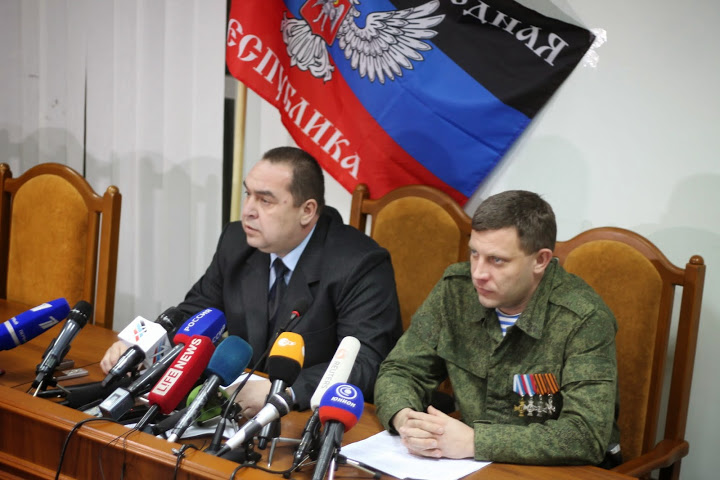
Ukraine Skeptical Toward Buffer Zone Proposal in Minsk Contact Group
Publication: Eurasia Daily Monitor Volume: 12 Issue: 153
By:

Soon after the signing of the Minsk Two armistice (February 2015), the Minsk Contact Group began considering a further set of military disengagement measures in Ukraine’s east. The Minsk Contact Group—Russia, Ukraine, the Organization for Security and Cooperation in Europe OSCE), and the Donetsk and Luhansk “people’s republics” (“DPR, LPR”)—has worked out this new document without, however, seriously attempting to implement the existing military clauses of the armistice, and in the absence of reliable verification means. Ukraine’s Western partners apparently endorse this approach from outside the Minsk Contact Group.
The Contact Group’s latest meetings, on July 21 and August 3–4, had each been expected to result in approval of the new document. The “DPR-LPR presidents,” Aleksandr Zakharchenko and Igor Plotnitsky, were expected to attend and sign the document alongside Leonid Kuchma, Ukraine’s former president and current chief delegate to the Minsk Contact Group. This would have been the same political constellation of signatories as to the Minsk One and Minsk Two armistice documents. Ukraine was supposed to overcome its own substantive reservations and sign for political reasons (Belta, Interfax, Donetskoye Agentstvo Novostey, July 21, August 4).
Technically, however, it was the Contact Group’s working group on security issues that drafted the new set of disengagement measures. Ukraine’s chief delegate to that working group, Yevhen Marchuk, has apparently persuaded Kyiv to delay the signing, and demand security guarantees along with the disengagement, instead of empty measures and further concessions. Marchuk is highly respected as a former defense minister and state security chief (among other posts) and long-time proponent of ties with the North Atlantic Treaty Organization (NATO). President Petro Poroshenko brought Marchuk back from retirement this year to appoint him as chief delegate to the Minsk working group on security issues.
The proposed measures would include establishing a buffer zone and a pilot (experimental) demilitarized zone between “the parties to the conflict” (Ukraine and the “DPR-LPR”; without mentioning Russia).
This buffer zone would involve a pullback of all tanks and armored combat vehicles, mortars with calibers of 120 millimeters or less, and artillery with calibers of 100 millimeters or less, from the “contact line” (frontline) to a distance of 15 kilometers on either side of that line. Infantry forces would evidently remain in the proposed buffer zone. Sketchy open-source reports do not clarify the definition of contact line in this document.
The new document’s “buffer zone” is not to be confused with the far wider “safety zones” in the Minsk Two armistice. The Minsk Two safety zones prohibit the stationing of missile and artillery systems with calibers exceeding 100 millimeters, as well as mortars with calibers over 120 millimeters. Those safety zones do allow tanks and armored combat vehicles. Furthermore, the Minsk Two armistice speaks confusingly of two contact lines, potentially creating disputable grey zones (see accompanying article).
Under all existing disengagement and pullout scenarios, including the buffer zone now proposed, the key locations in the Ukrainian-liberated territory would still be within the range of Russia’s heavy artillery systems. Such locations include Kramatorsk, Sieverodonetsk (administrative centers of the liberated parts of the Donetsk and Luhansk provinces), Avdiivka (with Ukraine’s largest metallurgical coke plant) and, of course, Mariupol.
The secessionist authorities apparently want the pullbacks to be effected by both sides simultaneously, from the entire demarcation line, in one fell swoop. Nevertheless, Donetsk-Luhansk seem unwilling to pull back their heavy forces from Debaltseve. For its part, Kyiv seeks phased-in, sector-by-sector pullbacks, with Pesky and Schastya (near the cities of Donetsk and Luhansk, respectively) to be reserved for the final phase (Donetskoye Agentstvo Novostey, August 7).
According to Oleksiy Haran, a prominent Kyiv analyst, initiatives toward separation of forces can be welcomed insofar as they take Ukrainian troops out of the range of direct artillery fire or surprise armor attacks. Buffer zones can frustrate Russia’s attrition warfare tactics that aim to exhaust Ukraine. In this case, however, there is no reliable monitoring and verification agency, and no arrangement for Ukrainian police to be responsible for law enforcement in buffer or demilitarized zones or gray areas. “Joint patrolling” by Ukrainian police and “DPR-LPR police” would be unacceptable to Ukraine (UNIAN, August 6).
Prefacing Kyiv’s objections and reservations, Foreign Affairs Minister Pavlo Klimkin noted that artillery and tank pullbacks were Kyiv’s idea in the first place. The existing document, however, contains no assurances that the other side would not seize additional localities, as it did after the Minsk One and Minsk Two disengagement measures. Unlike those measures, any new disengagements must be accompanied by guaranteed monitoring and verification on the part of the OSCE. The organization’s Special Monitoring Mission must be allowed to enlarge its personnel, install permanent posts at all the key points along the contact line, and be granted “unlimited access” to verify and inspect military units, including Russian military units present unlawfully on Ukrainian territory (Ukraiynska Pravda, August 7).
By all indications, the buffer zone proposal in its existing form offers no security guarantees to Ukraine against further encroachments, nor does it provide for a reliable monitoring, verification and inspection agency. Thus, the proposal falls short of addressing the fatal flaws of its more ambitious predecessors, Minsk One and Two. Apparently, those Western diplomats who advise Kyiv to accept this new document in its existing form no longer hope to rectify the consequences of the Minsk Two armistice. They seem, instead, content with another unverifiable, unenforceable arrangement that would look like a disengagement on paper.




